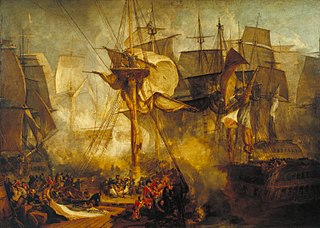
1805 (MDCCCV) was a common year starting on Tuesday of the Gregorian calendar and a common year starting on Sunday of the Julian calendar, the 1805th year of the Common Era (CE) and Anno Domini (AD) designations, the 805th year of the 2nd millennium, the 5th year of the 19th century, and the 6th year of the 1800s decade. As of the start of 1805, the Gregorian calendar was 12 days ahead of the Julian calendar, which remained in localized use until 1923.

The Battle of Trafalgar was a naval engagement that took place on 21 October 1805 between the British Royal Navy and the combined fleets of the French and Spanish Navies during the War of the Third Coalition of the Napoleonic Wars (1803–1815).

The Napoleonic Wars (1803–1815) were a series of conflicts fought between the First French Empire under Napoleon Bonaparte (1804–1815) and a fluctuating array of European coalitions. The wars originated in political forces arising from the French Revolution (1789–1799) and from the French Revolutionary Wars (1792–1802), and produced a period of French domination over Continental Europe. The wars are categorised as seven conflicts, five named after the coalitions that fought Napoleon, plus two named for their respective theatres; the War of the Third Coalition, War of the Fourth Coalition, War of the Fifth Coalition, War of the Sixth Coalition, War of the Seventh Coalition, the Peninsular War, and the French invasion of Russia.
Horatio Hornblower is a fictional officer in the British Royal Navy during the Napoleonic Wars, the protagonist of a series of novels and stories by C. S. Forester. He later became the subject of films and radio and television programmes, and C. Northcote Parkinson elaborated a "biography" of him, The True Story of Horatio Hornblower.

HMS Bellerophon, known to sailors as the "Billy Ruffian", was a ship of the line of the Royal Navy. A third-rate of 74 guns, she was launched in 1786. Bellerophon served during the French Revolutionary and Napoleonic Wars, mostly on blockades or convoy escort duties. She fought in three fleet actions: the Glorious First of June (1794), the Battle of the Nile (1798) and the Battle of Trafalgar (1805). While the ship was on blockade duty in 1815, Napoleon boarded Bellerophon so he could surrender to the ship's captain, ending 22 years of almost continuous war between Britain and France.

Richard Doddridge Blackmore, known as R. D. Blackmore, was one of the most famous English novelists of the second half of the nineteenth century. He won acclaim for vivid descriptions and personification of the countryside, sharing with Thomas Hardy a Western England background and a strong sense of regional setting in his works.
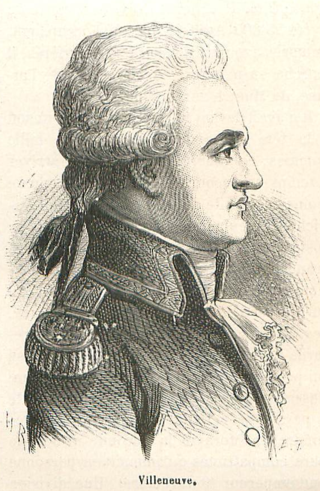
Pierre-Charles-Jean-Baptiste-Silvestre de Villeneuve was a French naval officer during the Napoleonic Wars. He was in command of the French and the Spanish fleets that were defeated by Horatio Nelson at the Battle of Trafalgar.
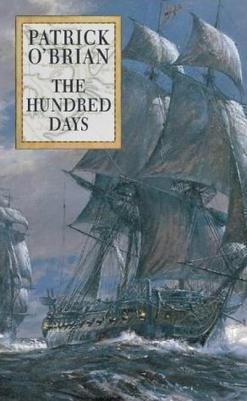
The Hundred Days is the nineteenth historical novel in the Aubrey-Maturin series by British author Patrick O'Brian, first published in 1998. The story is set during the Napoleonic Wars, specifically in their last portion in 1815, the Hundred Days.

HMS Agamemnon was a 64-gun third-rate ship of the line of the British Royal Navy. She saw service in the American Revolutionary War, French Revolutionary, and Napoleonic Wars and fought in many major naval battles. She is remembered as Horatio Nelson's favourite ship, and she was named after the mythical ancient Greek king Agamemnon, the first ship of the Royal Navy to bear the name.

Admiral Sir William Sidney Smith was a British naval and intelligence officer. Serving in the American and French revolutionary wars and Napoleonic Wars, he rose to the rank of Admiral.

Admiral Sir Robert Calder, 1st Baronet, was a British naval officer who served in the Seven Years' War, the American Revolutionary War, the French Revolutionary Wars and the Napoleonic Wars. For much of his career he was regarded as a dependable officer, and spent several years as Captain of the Fleet under Admiral Sir John Jervis. However, he is chiefly remembered for his controversial actions following the Battle of Cape Finisterre in 1805 which resulted in his court-martial. Though he was removed from his sea command, he was retained in the Navy and later served as Commander-in-Chief of the base at Plymouth.
The Dynasts is an English-language closet drama in verse and prose by Thomas Hardy. Hardy himself described this work as "an epic-drama of the war with Napoleon, in three parts, nineteen acts and one hundred and thirty scenes". Not counting the Forescene and the Afterscene, the exact total number of scenes is 131. The verse is primarily iambic pentameter, occasionally tetrameter, and often with rhymes. The three parts were published in 1904, 1906 and 1908.
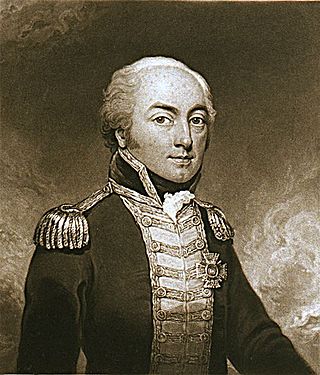
Rear-Admiral Sir George Johnstone Hope, KCB, KSO was a British naval officer, who served with distinction in the Royal Navy throughout the French Revolutionary and Napoleonic Wars, including service at the Battle of Trafalgar. A close personal friend of Admiral Nelson, he received many honours following the battle, and later served as a Lord of the Admiralty.

The Trafalgar campaign was a long and complicated series of fleet manoeuvres carried out by the combined French and Spanish fleets; and the opposing moves of the Royal Navy during much of 1805. These were the culmination of French plans to force a passage through the English Channel, and so achieve a successful invasion of the United Kingdom. The plans were extremely complicated and proved to be impractical. Much of the detail was due to the personal intervention of Napoleon, who as a soldier rather than a sailor failed to consider the effects of weather, difficulties in communication, and the Royal Navy. Despite limited successes in achieving some elements of the plan the French commanders were unable to follow the main objective through to execution. The campaign, which took place over thousands of miles of ocean, was marked by several naval engagements, most significantly at the Battle of Trafalgar on 21 October, where the combined fleet was decisively defeated, and from which the campaign takes its name. A final mopping up action at the Battle of Cape Ortegal on 4 November completed the destruction of the combined fleet, and secured the supremacy of the Royal Navy at sea.

Alice Lorraine: a tale of the South Downs is a novel by R. D. Blackmore, published in 1875. Set in Sussex and Spain during the Napoleonic Wars, the novel recounts the divergent tales of the eponymous heroine and her brother in their efforts to save the noble Lorraine family from ruin.
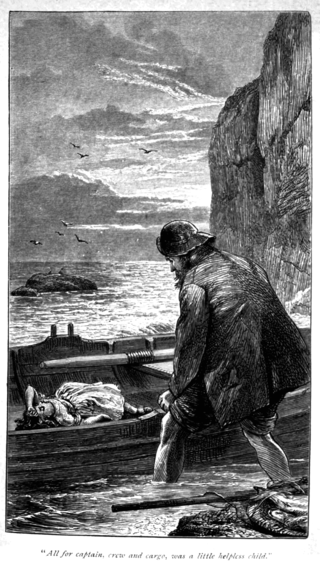
The Maid of Sker is a three-volume novel that was written by R. D. Blackmore and published in 1872. The novel is set in the late 18th century and is about an elderly fisherman who unravels the mysterious origins of a foundling child who is washed ashore on the coast of Glamorganshire, South Wales. It was published subsequent to Blackmore's Lorna Doone, although he had begun writing The Maid of Sker 25 years earlier. Blackmore considered The Maid of Sker to be his best novel.

Mary Anerley: a Yorkshire tale is a three-volume novel by R. D. Blackmore published in 1880. It is set in the rugged landscape of Yorkshire's North Riding and the sea-coast of its East Riding.

Perlycross: a tale of the western hills is a three-volume novel by R. D. Blackmore published in 1894. The story is set in eastern Devon around 1830.
The Napoleonic Wars were a defining event of the early 19th century, and inspired many works of fiction, from then until the present day.
The French Imperial Navy was the name given to the French Navy during the period of the Napoleonic Wars, and subsequently during the reign of Napoleon Bonaparte. The first use of the title 'Imperial Navy' was in 1804, following the Coronation of Napoleon, a name derived from the old French Navy under The Republic. It notably saw action at the Battle of Trafalgar, and its defeat prevented Napoleon's planned invasion of the United Kingdom. After the First Bourbon Restoration in 1814, the navy was renamed to its old title of French Royal Navy, but after Napoleon's return in March 1815, briefly became the Imperial Navy once more. Following the Second Bourbon Restoration, the navy once again became royal, and the title wasn't used again.















